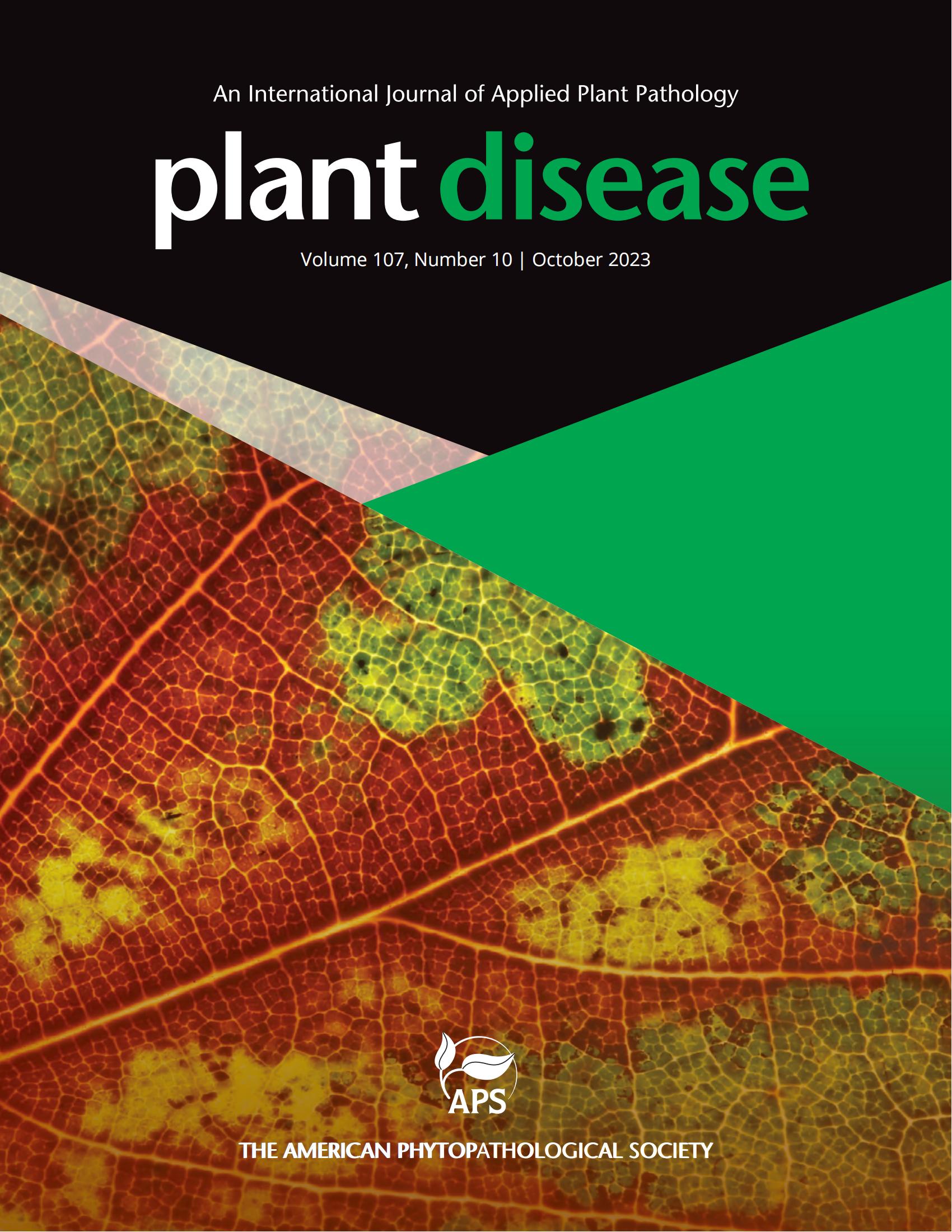首次报告美国北卡罗来纳州西兰花上由黄铜交替孢属植物引起的交替孢属叶斑病。
摘要
2023 年 9 月,北卡罗来纳州(NC)班科姆县(Buncombe County)一个有机农场的西兰花(Brassica oleracea var. italica)'Sweet Bunch'植株出现了 Alternaria 叶斑病的症状。病害影响了所有(约 30 株)植物 10% 到 20% 的叶面积。病斑呈黑褐色,有绿晕,形状不规则,直径小于 3 厘米。叶片样本在湿度箱中培养 24 小时后,根据分生孢子形态确定病原体为黄铜交替丝核菌(Rimmer 等人,2007 年;补充图 1)。将病变边缘的叶片(2 x 2 毫米)表面消毒(1% 次氯酸钠溶液)1 分钟,用无菌蒸馏水冲洗,包埋在马铃薯葡萄糖琼脂中,在 22°C 和 12 小时光周期下培养。将菌丝顶端转移到 20% V8 果汁琼脂上,按上述方法培养,获得纯培养物。10 d 后,菌落由白色至棕色的同心菌丝带和白色气生菌丝组成。7 d 内,观察到分生孢子长 80 至 150 µm,有 0 至 3 个纵隔膜、6 至 15 个横隔膜和一个长喙,该分离物被初步鉴定为 A. brassicae(Rimmer 等,2007 年)。为确认其身份,从菌丝体中提取了 DNA,并使用引物进行 PCR 扩增 rDNA 内部转录间隔(ITS:ITS1/ITS4)(White et al.1990)、转录延伸因子-1(tef1:EF1-728F/EF1-986R)(Carbone 和 Kohn,1999 年)和甘油醛-3-磷酸脱氢酶基因(GAPDH:gpd1/gpd2)(Berbee 等,1999 年)。扩增子在 Eton Bioscience(北卡罗来纳州达勒姆)进行了测序,并在 NCBI GenBank 中进行了 BLAST 分析。序列与 A. brassicae CBS 116528 编号 KC584185(ITS)、KC584641(tef1)和 KC584102(GAPDH)吻合(99.5% 至 100%)(Woudenberg 等人,2013 年)。所有序列都存入了 NCBI GenBank(登录号 PP584506、PP584507 和 PP584508)。为了确认西兰花和羽衣甘蓝(B. oleracea var. sabellica)的致病性,将生长在 10 厘米直径花盆中的西兰花 "Sweet Bunch"、"Eastern Crown "和 "Green Magic "以及羽衣甘蓝 "Winterbor"、"Darkibor "和 "Oldenbor "的 5 周大植株按作物类型分开,并按栽培品种排列成四个随机完整区组。每个区组包含每个栽培品种的单株重复,这些重复要么接种,要么不接种。将从 10 天培养物(3.5 x 103 个分生孢子/毫升)中获得的黄铜穗蚜分生孢子喷洒在每株接种植物上,直至分生孢子流出。未接种的植物用蒸馏水喷洒。植物在湿度室中与温室环境交替培养,每 48 小时一次,持续 10 天,温室平均温度为 15 至 28°C。实验进行了两次。在接种后 5 d 内,所有接种植株的叶片上都出现了直径为 1 至 3 mm 的深褐色至灰色病斑(补图 2),未接种植株则保持健康。在西兰花植株上,病斑呈同心环状扩大,接种 10 d 后在叶片组织和叶柄上观察到病原体的孢子。甘蓝植株上的病斑仍然很小(< 3 毫米),也未观察到孢子。用上述方法从所有接种品种的叶片组织中重新分离出了黄铜链格孢属(Alternaria brassicae)。通过菌落和分生孢子的形态确认了病原体的身份。目前尚不清楚 A. brassicae 对芸薹属植物的更大影响,但在美国东部发现这种不太常见的 Alternaria 物种可能会对宿主抗性的发展和杀真菌剂的药效产生影响(Nieto-Lopez 等,2023 年)。In September 2023, broccoli (Brassica oleracea var. italica) 'Sweet Bunch' plants on an organic farm in Buncombe County, North Carolina (NC), displayed symptoms of Alternaria leaf spot. Disease affected 10 to 20% of leaf area on all (approximately 30) plants. Lesions were dark brown with chlorotic halos, irregular in shape, and ≤3 cm in diameter. Leaf samples were incubated in a humidity chamber for 24 h, and the pathogen was putatively identified as Alternaria brassicae based on conidial morphology (Rimmer et al. 2007; Supplemental Fig. 1). Leaf pieces (2 x 2 mm) spanning lesion edges were surface-disinfested (1% sodium hypochlorite solution) for 1 min, rinsed in sterile distilled water, embedded in potato dextrose agar, and incubated at 22°C with a 12-h photoperiod. A pure culture was obtained by transferring a hyphal tip onto 20% V8 juice agar and incubated as above. After 10 d, colonies consisted of concentric zones of white to brown mycelia with white, aerial mycelia. Within 7 d, conidia measuring 80 to 150 µm long with 0 to 3 longitudinal septa, 6 to 15 transverse septa, and a long beak were observed, and the isolate was putatively identified as A. brassicae (Rimmer et al. 2007). To confirm identification, DNA was extracted from mycelia and subjected to PCR using primers to amplify a portion of the internal transcribed spacer of rDNA (ITS: ITS1/ITS4) (White et al. 1990), the transcription elongation factor-1 (tef1: EF1-728F/EF1-986R) (Carbone and Kohn 1999), and the glyceraldehyde-3-phosphate dehydrogenase gene (GAPDH: gpd1/gpd2) (Berbee et al. 1999). Amplicons were sequenced at Eton Bioscience (Durham, NC) and subjected to BLAST analysis in NCBI GenBank. Sequences matched (99.5 to 100% identity) A. brassicae CBS 116528 accessions KC584185 (ITS), KC584641 (tef1), and KC584102 (GAPDH) (Woudenberg et al. 2013). All sequences were deposited in NCBI GenBank (accessions PP584506, PP584507, PP584508). To confirm pathogenicity on broccoli and kale (B. oleracea var. sabellica), 5-week-old plants of broccoli 'Sweet Bunch', 'Eastern Crown', and 'Green Magic' and kale 'Winterbor', 'Darkibor', and 'Oldenbor' grown in 10-cm-diameter pots were separated by crop type and arranged in four randomized complete blocks by cultivar. Each block contained single-plant replicates of each cultivar that were either inoculated or non-inoculated. Conidia of A. brassicae obtained from 10-d-old cultures (3.5 x 103 conidia/ml) were sprayed onto each inoculated plant until run-off. Non-inoculated plants were sprayed with distilled water. Plants were incubated in a humidity chamber alternated with ambient greenhouse conditions every 48 h for 10 d, with average greenhouse temperatures ranging from 15 to 28°C. The experiment was conducted twice. Dark brown to gray lesions measuring 1 to 3 mm in diameter were observed on leaves of all inoculated plants within 5 d of inoculation (Supplemental Fig. 2), and non-inoculated plants remained healthy. On broccoli plants, lesions expanded in concentric rings, and sporulation of the pathogen was observed on leaf tissue and petioles 10 d after inoculation. Lesions remained small (< 3 mm) on kale plants, and sporulation was not observed. Alternaria brassicae was re-isolated from leaf tissue of all inoculated cultivars using methods described above. Pathogen identity was confirmed via colony and conidial morphology. The larger impact of A. brassicae on brassicas is unknown, but finding this less common Alternaria species in the eastern United States could have implications for host resistance development and fungicide efficacy (Nieto-Lopez et al. 2023).

 求助内容:
求助内容: 应助结果提醒方式:
应助结果提醒方式:


